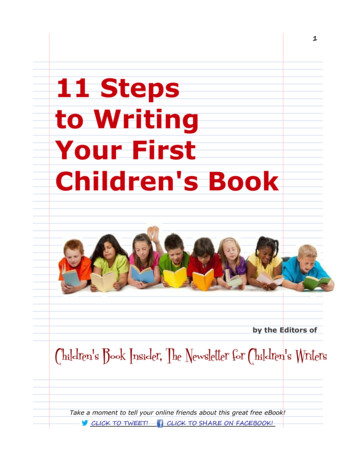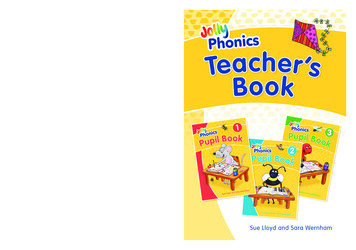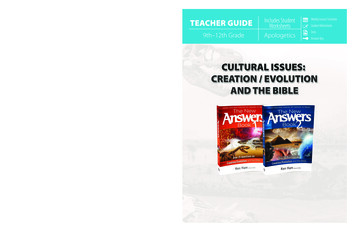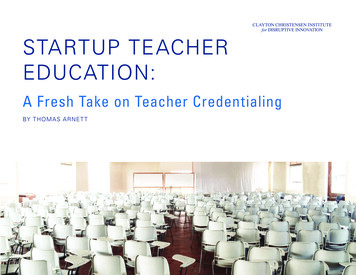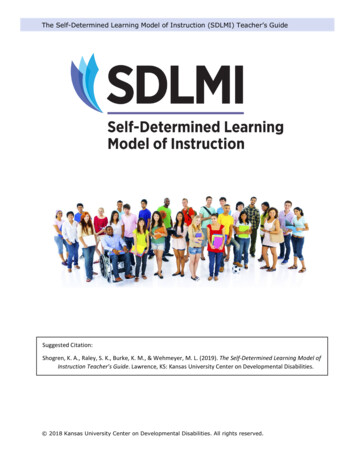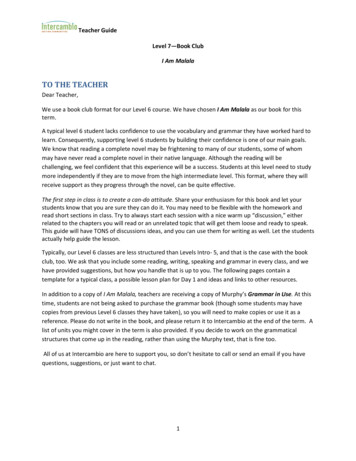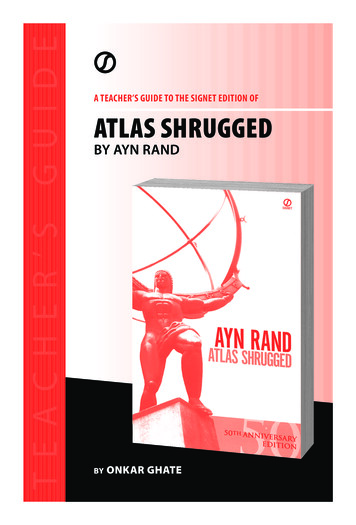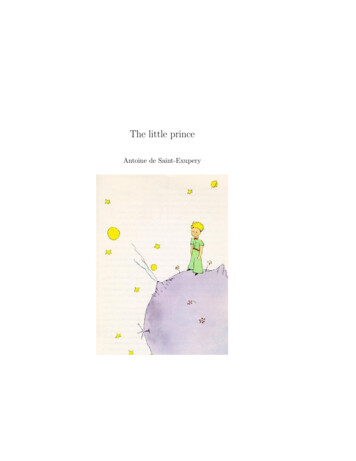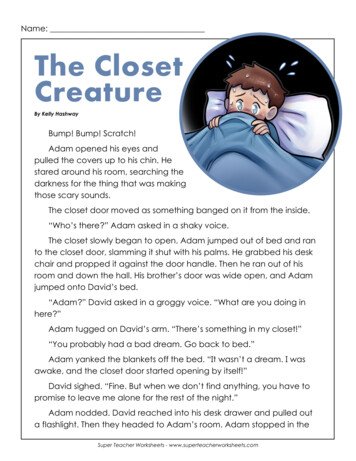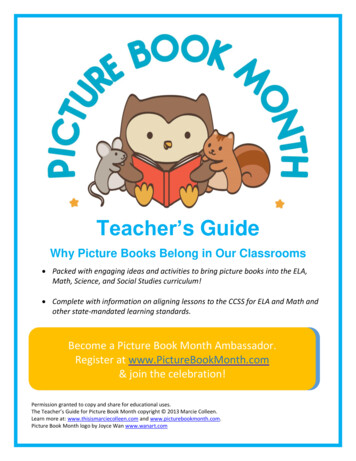
Transcription
Teacher’s GuideWhy Picture Books Belong in Our Classrooms Packed with engaging ideas and activities to bring picture books into the ELA,Math, Science, and Social Studies curriculum! Complete with information on aligning lessons to the CCSS for ELA and Math andother state-mandated learning standards.Become a Picture Book Month Ambassador.Register at www.PictureBookMonth.com& join the celebration!Permission granted to copy and share for educational uses.The Teacher’s Guide for Picture Book Month copyright 2013 Marcie Colleen.Learn more at: www.thisismarciecolleen.com and www.picturebookmonth.com.Picture Book Month logo by Joyce Wan www.wanart.com
What is Picture Book Month?Picture Book Month is an international literacy initiative that celebrates print picture books during the month ofNovember.Founder, Dianne de Las Casas (author & storyteller) www.diannedelascasas.com, and Co-Founders, Katie Davis(author/illustrator) www.katiedavis.com, Elizabeth O. Dulemba (author/illustrator) www.dulemba.com, TaraLazar (author) taralazar.wordpress.com, and Wendy Martin (author/illustrator) wendymartinillustration.com,put together their worldwide connections to make this happen.Every day in November, there is a new post from a picture book champion explaining why he/she thinks picturebooks are important.In this digital age where people are predicting the coming death of print books, picture books (the print kind)have so much to offer that they must be celebrated and shared. And the world needs picture books. There’snothing like the physical page turn of a beautifully crafted picture book.What You Can Do to Celebrate Picture Book Month?* Become a Picture Book Month Ambassador and place the Ambassadorbadge on your website, with a link to www.PictureBookMonth.com.* Register at www.PictureBookMonth.com so that you can pledge tocelebrate your love of picture books throughout the month of November.You will also be added to the Picture Book Month mailing list.* Create posters and hang them around your school and library. Postersare available for download online in the media kit. Be sure to include thebook covers of your favorite picture books.* Download the theme calendar for Picture Book Month to help youcreate a month-long celebration of picture books.* Count how many picture books are checked out and keep a running total. At the end of the month, let us know how manyyour school or library read!* Tweet the cause and/or reviews of your favorite picture books. Use the hashtag #picturebookmonth* Get the Picture Book Month Twibbon, a digital ribbon that can be added to your Twitter avatar or Facebook profilepicture. Details online.* Ask a picture book author/illustrator to visit or do a Skype visit to your school or library.* Post a review of your favorite picture book to Amazon.com, Goodreads, Library Thing, or your blog.* Follow Picture Book Month (@picturebkmonth) and founder Dianne de Las Casas (@AuthorDianneDLC) on Twitter forupdates every day in November. You can find Picture Book Month on Facebook, too.November is Picture Book Month. Read * Share * Celebrate!1
Table of ContentsThe Heart of Learning: Why Picture Books Belong in Our Classrooms3English Language Arts4Teacher Testimonial: Picture Books as Mentor Texts for Writing6Math7Science9Teacher Testimonial: Two Teachers, Countless Possibilities11Social Studies12Helpful Resources14Share Your Ideas15How To Use This GuideThis teacher’s guide for Picture Book Month is designed to help teachers integrate picture books intoEnglish language arts (ELA), mathematics, science, and social studies curricula. Art and drama areencouraged throughout the guide and all activities were created in conjunction with relevant contentstandards in ELA, math, science, and social studies.2
The Heart of Learning: Why Picture Books Belong in OurClassroomsWith the rise of bullying in our schools, how can we deny that our classrooms need more heart?The danger is that with the implementation of mandated learning standards, teachers feel forced tospend more time teaching to “the test,” in lieu of teaching matters of the heart—or worse yet,teaching with their hearts.Picture books can address both heart and the standards. Picture books allow for story. Picturebooks teach empathy. Picture books help relate human experiences to academic concepts and addresscomplex issues and content. And because picture books have a short focused format, the academicconcepts and complex issues become readily accessible to children.This guide is not meant to be an instruction book on what exactly to do to bring picture booksinto your classroom. Instead it serves as a celebration and call-to-action to springboard your own ideasfor using picture books in your classroom. By focusing on the academic concepts deemed necessary bystate and federal mandated learning standards, this guide sets out to empower teachers to considerpicture books as valuable resources, which connect students with content and inspire their humanity.Any picture book can be tied into the CCSS and other state standards. Therefore, teachers should feelauthorized to choose the texts they want to teach and find alignment from there, not the other wayaround.Lately, non-fiction picture books have been getting a lot of attention and although non-fictionpicture books provide wonderful content for inclusion within the classroom, it is my wish that fictionpicture books would be given the same attention and opportunity to thrive within the academicenvironment.My hope is that this guide provides inspiration, validation, and celebration for all picture booksin every classroom.Marcie Colleen, Picture Book Month’s Education Consultant, has been in education for 18 years.She is a former New York classroom teacher and has served as a curriculum creator for the CentralNew York Institute of Aesthetic Education, Syracuse Stage, Tony Randall’s National Actors Theater,and various Broadway and Off-Broadway shows. She was the Director of Education for TADA! YouthTheater in NYC creating and managing educational programming reaching over 30,000 studentsand families in the NYC Metro area a year. Her Teacher’s Guides for picture books and middle gradenovels can be found at www.thisismarciecolleen.com.3
English Language ArtsWhy Picture Books?Based on the Common Core StateStandards for English Language Arts& Literacy in History/Social Studies,Science and Technical Subjects andthe National Council of Teachers ofEnglish and the InternationalReading Association Standards forthe English Language Arts.Concepts:* Reading* Writing Picture books are wonderful tools for teaching storystructure, key ideas, and details because of their simple linearplot lines and setting, with a few highly developed characters. Picture books prompt a variety of creative writingassignments. Picture books lend themselves nicely to technical writingassigments, including but not limited to letters to authors orillustrators, book reviews, research papers based on a themefound within the story.* Speaking & Listening*Language Picture books are specifically and technically crafted.Due to the concise and simple nature of the genre, word choiceand structure is extremely important. Picture books are meant to be read-aloud, which automatically makes them a social experience. The very nature of reading a picture book invites conversation and questions that supportstudents developing understandings of language and their world. Picture books contain many literary conventions including but not limited to, rhyme,onomatopoeia, alliteration, hyperbole. Visuals in the illustrations build skills for determining meaning through context.Classroom Activities:How I See It Choose a character, other than the main protagonist, and write the story from theirPoint of View. Use The True Story of the 3 Little Pigs as told by Jon Scieszka and illustrated by LaneSmith, as an example. For another challenge, the students could place themselves in the story and telltheir own version.Reader’s Theater Create a Reader’s Theater version of the story. Cast students as the characters andhave them read the book’s dialogue or develop their own lines to best re-tell the story.4
Diaries, Letters, Journals, and Messages These creative writing assignments require students to useappropriate vocabulary, point of view, content and form, as well as enable students to experiment withdifferent purposes for writing. For example, using the traditional story of Goldilocks and the ThreeBears, students could write:o Goldilocks’ letter of apology to the bears;o Baby Bear’s letter to his best friend describing his experiences;o Newspaper articles by reporters regarding the “break-in”;o Police reports and witness statements;o Estimates for furniture repair from the Guild of Furniture Makers;o Goldilocks’ diary extries the day before the incident and the day after;o A letter to the author or illustrator of the book.Vocab Detectives Re-read sections of the book aloud and ask students to listen carefully for wordsthey do not know. As soon as they come across a new vocabulary word, they raise their hand. Repeatthe phrase using the unknown word. What might it mean, based on context? Look up the word in thedictionary. Read the definition. Come up with a way to remember what the word means. Using TotalPhysical Response, students can create an action that symbolizes the word and helps them rememberit. Create a list of the vocabulary words and hang it on the wall. Revisit it again and again.Instructional Read Alouds Reading a story aloud in class includes pre-reading, during reading, andpost-reading activities to make sure the class understands and makes connections with the story. Thisconstant verbal interaction can help build a student’s desire and confidence to read independently.5
Teacher TestimonialPicture Books as Mentor Texts for Writingby Marcie Flinchum AtkinsPicture books matter. They matter because they can be loved and used on so many differentlevels. I teach fourth graders. Many people think that’s the age when kids are “too old” for picturebooks. They can read harder books by this age, usually. But picture books are for so much more thanjust stepping stones in reading. I use them extensively in teaching children how to write.Picture books are the perfect mentor text for writing. They are short, yet the language andstructure are complex. Picture books allow for pleasure reading, but they also leave room for revisiting.Owl Moon is a book that my students have usually heard a half-dozen times before they enter fourthgrade. When I pull it out and they say, “Oh, I’ve read this book,” I’m thrilled. This means that they don’thave to concentrate on what happens, they can concentrate on how Yolen uses her writing techniquesto give us sensory details of that owling night.When I introduce Denise Fleming’s In the Small, Small Pond, it appears to be a book fortoddlers—much too young for fourth graders. Yet, Fleming’s use of poetic language and her vivid verbsmake this short book perfect for wrapping students in word choice.Even Michael Ian Black’s hilarious A Pig Parade is a Terrible Idea seems like just a laugh-outloud funny read. It is. But what a great example of tone—something that’s very hard to find examplesof.The Quiet Book by Deborah Underwood is also a very short text but serves as a great exampleof choosing the exact right word for what you want to convey. Not just quiet. What kind of quiet?Picture books matter in the classroom—even in the intermediate elementary classroom. Theyshouldn’t disappear and be replaced with middle grade novels just because kids can now read them.We need to continue to revisit favorites from early childhood and introduce students to new titlesbecause stories in picture books are some of the greatest writing examples we can give to students.Marcie Flinchum Atkins teaches fourth graders by day and writes picture books,middle grade and YA novels in the wee hours of the morning. She also writesmentor texts lesson plans for her website: ext-lessons/6
MathWhy Picture Books?Based on the Common CoreState Standards forMathematics and TheCurriculum and EvaluationStandards for SchoolMathematics and Focal Pointsfrom the National Council ofTeachers of Mathematics.Concepts: Picture books aid students in visualizing mathematicswithin a narrative context. Picture book illustrations lend themselves nicely tocounting exercises (“how many apples can you find?”). Picture books help students visualize number quantitiesand number comparison (“how many more apples does this tree* Numbers andOperationshave than that tree?”).*Algebraic Thinkingproblems, using a plot line and characters that students know and*Geometry relate to. * Measurement and DataPicture books provide excellent scenarios for wordPicture book illustrations serve as wonderful models of howshapes are used to create pictures. Picture books help students visualize what they are readingand make sense of the content which is a big component in spatial learning and problemsolving. Picture books provide context, which supports developing understandings of mathematicalconcepts such as measurement and timeClassroom Activities:Scavenger Hunt What’s more fun than a scavenger hunt to sharpen counting skills? In line with atheme or item in a story, ask students to find 1 of something, 2 of something, 3 of something, and soon until you reach 10 (ex. Find 1 pencil, 2 markers, 3 books, 4 erasers, etc)—or allow kids todetermine what items to collect themselves, as long as they meet the quantity requirements.The Geometry of Illustration Using simple shapes cut out of various colored paper, have studentsrecreate a character or illustration from a picture book. As an added challenge, provide several threedimensional “found objects”. The recycling bin can be a haven for cubes, spheres and cones. Usingthese objects have students create a three dimensional sculpture of a picture book character.7
The Secret Message Code game Although this activity is in the Math section of this guide, it definitelyhas cross-over with ELA as it teaches letter recognition, spelling, and reading depending on the level ofthe students. Assign a number to each letter in the alphabet (ie. A 1, B 2, C 3, and so on). Create themessage (based on the story) , only using a blank to represent each letter. Under each blank, place amath equation that would lead to the necessary letter. For example 1 3 under a blank means that thatblank should contain a D, because D 4. Do this with the entire message and have students try andfigure out the Secret Message. Depending on the level of the students, this activity can be done as aclass or individually.Data Collection & Surveys This activity is a great get-to-know-you activity for the beginning of theyear.o As a class, create a survey about favorite things. For example: Favorite character; Favoritebook; etc.o Take a tally from the class, and then construct a graph to record everyone’s answers.Analyze the graph (9 out of 25 like Little Red, and 4 out of 25 like Rapunzel).o Together, make up a list of survey questions to ask 100 people.o Groups of 5 ask 20 people each (so you have a sample size of 100) by visiting other classes,the library, the office, and so forth. Once collected, the groups work to sort and classify theresults, and create graphs. Have the groups depict findings in fraction form, too. Using thenumber 100 allows a brief introduction to decimals and percentages.GUESS WHAT?Although books come in many shapes and sizes, picture books aredesigned to be easily held and transported by kids.As a class, gather some favorites. Using a measuring-tape and ascale determine the book’s weight and dimensions.Who is the intended age group? Why do you think the publisherchose this size, weight and shape for the book?8
ScienceBased on the learning standardsdeveloped by the NationalResearch Council (NRC) of theNational Academy of Science,which argue for more depth,understanding, and thinking andless memorization, mechanics andmimicry.Concepts:*Science as Inquiry*Physical Science*Life ScienceGUESS WHAT?There is a wide variety of non-fiction and informationalpicture books which are excellent resources, however,fiction books can introduce scientific concepts, as well.This section was created with both non-fiction and fictionpicture books in mind.Why Picture Books? Children are born scientists; and picture books, likeScience, are about the spirit of curiosity and exploration. Although fiction picture books provide fantasticalelements, these stories provide wonderful springboards forconversation about fact vs. fiction and can spark the desire for*Earth and Space Science*Science and Technology*History and Nature ofSciencefurther research. Literature takes us to places we cannot go when inside aclassroom; and additionally, through the use of illustrations andphotographs picture books can show us places we are unable togo to ourselves. Picture books offer a narrative and humanization to several scientific concepts. Picture books give us a more intimate look at scientific concepts that are often abstract anddifficult to understand. The technological debate of traditional vs. digital picture books and whether technologyalways means progress is a great topic for the classroom. Picture books provide opportunities to develop students’ background knowledge and forfrontloading before the beginning of a new unit.Classroom Activities:Text-plorers Real scientists are always asking questions and seeking answers. Ask your students to bescientists or “text-plorers.” Page by page read the story aloud. Ask students what questions they haveafter each page. Make sure to record all questions. No questions are silly. At the end of the book,review the list of questions and discuss possible answers. Some questions may have been answered inthe story. Maybe some kids would want to guess or “hypothesize” the answers that are still unknown.9
Now research the answers in the library or on the computer. Assign certain questions to specificstudents or the entire class may research together as a way to demonstrate good research skills tothose who might not be as experienced.Optional: Explain what a “footnote” is. Create index cards for each question/answer and fix them withtape to the appropriate pages in the book as a reference.Non-fiction Show ‘n Tell Ask students to bring in a nonfiction book or a “found fact” from the Internet thatcorresponds with topics within a story studied in class.For example, if the class reads Blueberries for Sal, a nonfiction book/”found fact” about black bears orblueberries would be suitable. Students then share theinformation with the rest of the class.Fact vs. Fiction game This activity focuses on listeningskills and knowing the difference between fact andfiction. The teacher stands at the front of room and thestudents line up across the back of the room.The teacher calls out a statement.The students move one step if they hear a fact.When a fictional statement is given, the students shouldnot move. Those who move at the wrong time must goback to the beginning.GUESS WHAT?The Scientific Method isn’t justfor Science class anymore!The scientific method can beused whenever there iscuriosity. It is a way to ask andanswer scientific questions bymaking observations and doingexperiments. Most scientists dothis without even thinking.However, there are specificsteps to the Scientific Method: Ask a QuestionStudents who reach the front, create the factual andfictional statements for the next round. The Scientist’s Eye Compare the illustrations in aPicture Book to a photograph of the real person, animal,place, or thing.Do BackgroundResearch/CollectInformation What are similarities and differences between the photoand the illustration?Form a Hypothesis or“possible explanation” Students take their own photos of something in thenatural world (nature, animals, land, etc) and createtheir own illustration of that photograph.Test Your Hypothesis byDoing an Experiment Record and Study Data Draw a ConclusionChoral Speak Using excerpted non-fiction text with asimilar theme to the picture book being studied and thepicture book itself, students create a choral readingjuxtaposing the two. After half of the students read each page of the picture book aloud together, theother half of the class will read a piece of the non-fiction text. At the conclusion, students discuss theirreactions to hearing the two pieces read together.10
Teacher TestimonialTwo Teachers, Countless PossibilitiesI have been teaching for over 20 years using picture books not only for reading and writing, but formath as well. Children learn best when they can make connections to their own lives. This is the waythey make sense of things. Picture books do that for children—they help them make connections andthey illustrate (no pun intended) how seemingly abstract ideas are meaningful. Many young childrenmight wonder why learn about measurements, shapes, or numbers? But when they listen to a storyabout how big a foot is, learn about geometry through triangles that are characters, they can relate.Better yet, picture books spark students’ interest, which begins a never-ending cycle of connections—that are so necessary for learning.Karen Kavalin is an Elementary School Teacher currently teaching 1st grade.Picture books can be an amazing resource for teachers when introducing new content, specifically insocial studies and science. The beauty of picture books is that they are written in a way that makesdifficult concepts accessible to children. The illustrations also provide more opportunities to connectwith the text and therefore the information. I’ve often used picture books at the beginning of a unit tobuild students’ background knowledge, as well as to develop common vocabulary and specificacademic language so the class can engage in deep and authentic learning. I’ve also developed manytopic specific text sets – so students read and learn about a topic through various types of picturebooks. For example, a text set might include picture books written in prose, narrative, or straightinformation. Showing students how information can be presented in different ways broadens anddeepens students’ understandings, as well as provides multiple entry points for students to connectwith and access the information. Picture books are the perfect resource in any classroom because theyaddress so many topics in truly engaging ways through well crafted, beautifully illustrated text.Rosanne L. Kurstedt, Ph.D., Adjunct Professor, Fordham University, co-author ofTeaching Writing with Picture Books as Models (Scholastic, 2000) and formerupper elementary school teacher.11
Social StudiesBased on Expectations of Excellence:Curriculum Standards for Social Studies,created by the National Council for theSocial Studies (NCSS).Concepts:*Culture*Time, Continuity, and Change*People, Places, andEnvironment*Individual Development andIdentity*Individuals, Groups, andInstitutionsWhy Picture Books? Picture books allow students to have vicariousexperiences through characters who are not like them. Picture books teach the universality of manyexperiences. Picture books help students make sense of the world. Picture books help students develop empathy. Picture books place a human face to historical,political, environmental, and cultural events. Picture books provide an emotional core which helpsconnect the students to the content. Picture books build empathy which is an importanttool for navigating through society.*Power, Authority, andGovernance Picture books not only tell a story of a culture orhistorical time, they also provide a visual into the world*Science, Technology, andSociety*Global Connectionsthrough illustrations. Picture books provide opportunities to developstudents’ background knowledge and for frontloading beforebeginningof a new unit.*CivictheIdeasand PracticesClassroom Activities:Find the Similarities Create Venn diagrams of the student and the main character. Focus on thesimilarities between the two. If possible, add an additional real-life person in the same circumstancesas the main character as a third circle.This is My Story Invite a guest speaker to visit or Skype with the classroom about either a cultural,political, historical, environmental or thematic element in the story.12
Book Pen Pals Arrange to have another classroom in a different town, city, state, or country read thesame story. Assign Pen Pals to your students and have them share book reviews. Pen Pals includeinformation about their own life and how they related to the story in their coorespondence.Write a Face to An Event Students write stories of a kid their ownGUESS WHAT?age during a historical, politcal, environmental, or cultural event.Social Studies is not justMap it or Timeline it Understanding how the world of a storyaboutgovernmentandlooks or the timeline of an event can help students understand thehistory.event itself. Students create timelines or maps of their own worldsabout people, the world andfor comparison.the inter-connectedness ofSocial Studies isall.What Would I Do? Read a Picture Book right up to the mainconflict. Brainstorm with the students different resolutions andStory, even when fictional,what their outcomes would be.Students can then placecan help students makethemselves physically on an imaginary line linking two alternatives.sense of their world throughAn open mind is indicated through placing oneself centrally, while“text to self” and “text tothe closer one stands to a chosen alternative the stronger one’sworld” connections.support. This allows students to see the potential range of opinionwithin a group. Students can share why they placed themselveswhere they did on the spectrum.Collective Drawing As a class, create a piece of artwork to represent the people and places in thestory.Still Image Sculpture Students devise an image using their own bodies to crystallize a moment, ideaor theme from the story. These still images are a form of expression and reflection for those inside theimage, but also a sign to be interpreted or read by the observers. Often, for tricky emotionalmoments, these still images communicate more than students could with words alone. Observerscreate caption for the physical illustrations.13
Helpful ResourcesThe StandardsThe Common Core State Standardswww.corestandards.orgELA standardswww.ncte.org/standards/ncte-iraMath standardswww.nctm.org/standardsScience standardswww.nap.edu/openbook.php?record id 13165Social Studies nal WebsitesMentor Texts Lesson Planswww.writingfix.com/picture book prompts.htmwww.julieballew.com/A Literate Life/Mentor Texts.htmlCommon Core ts.htmlPicture Book Database (Perfect Picture Book icture-books.htmlArticle -Using Picture Books to Empower and Inspire Readers and Writers in the Upper tem/495Instructional Read emes/rwproject/resources/ela/support materials/ela support chapter4.pdfAn Introduction to Total Physical al-physical-response/146503.articleBooksUsing Picture Books to Teach 8 Essential Literary Elements: An Annotated Bibliography of MoreThan 100 Books with Model Lessons to Deepen Students' Comprehension (Scholastic TeachingResources, 2012)Teaching Writing with Picture Books as Models: Lessons and Strategies For Using the Power ofPicture Books to Teach the Elements Of Great Writing in The Upper Grades (ScholasticProfessional Books, 2000)14
Teaching Literary Elements with Picture Books: Engaging, Standards-Based Lessons andStrategies (Scholastic Teaching Resources, 2009)Using Picture Books to Teach Comprehension Strategies: 30 Lessons That Teach Students the SixComprehension Strategies They Need to Actively Engage With Text and Read for Meaning(Scholastic Teaching Resources, 2008)Using Picture Books to Teach Writing with the Traits (Scholastic Teaching Strategies, Grades 3and Up) (Scholastic, Inc., 2004)Teaching about Nonfiction with Picture Books: Engaging Lessons, Activities, and Reproduciblesthat Introduce Key Nonfiction Features and Build Comprehension (Scholastic TeachingResources, 2008)The Power of Picture Books in Teaching Math, Science, and Social Studies: Grades PreK-8(Holcomb Hathaway, 2009) We would love to hear from you! Share your ideas with us!How will you celebrate Picture Book Month?Do you have plans to incorporate picture books into your daily classroom instruction? Do youwant to share a project you have in mind?To tell us your ideas, please visit: www.PictureBookMonth.comORemail: picturebookmontheducation@gmail.comAlso, be sure to connect with like-minded educators on Twitter and Facebook — simply tweetwith hashtag #picturebookmonth, or “like” the Picture Book Month Facebook page:www.facebook.com/PictureBookMonth.Special Thanks to Dianne de Las Casas, Carter Higgins, John Schumacher, Colby Sharp, Marcie Flinchum Atkins, JoannaMarple, Karen Kavalin, and Rosanne Kurstedt.15
* Get the Picture Book Month Twibbon, a digital ribbon that can be added to your Twitter avatar or Facebook profile picture. Details online. * Ask a picture book author/illustrator to visit or do a Skype visit to your school or library. * Post a review of your favorite picture book
